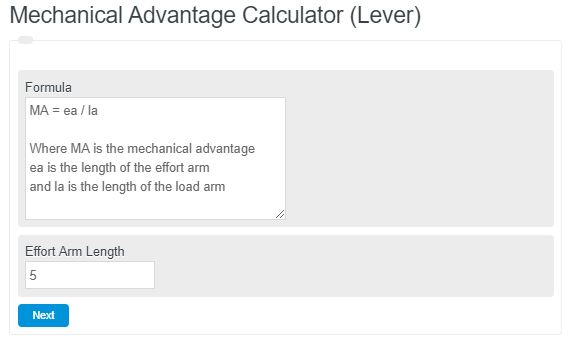Enter the length of the effort arm and the length of the load arm of a lever into the calculator below to determine the mechanical advantage.
- Pulley Weight Calculator
- AMA (Actual Mechanical Advantage) Calculator
- Belt Length Calculator (2 pulley system)
- Rocker Arm Ratio Calculator
- Lever Force Calculator
- Effort Force Calculator
- Wedge Force Calculator
- Output Force Calculator
Mechanical Advantage Formula
The following formula is used to calculate the mechanical advantage of a lever.
MA = ea / la
- Where MA is the mechanical advantage
- ea is the length of the effort arm
- and la is the length of the load arm
To calculate the mechanical advantage, divide the length of the effort arm by the length of the load arm.
Mechanical Advantage Definition
Mechanical advantage is a term used to describe the ratio of an output force to the input force. In other words, the amount of output with a given effort. Using physics and “leverages,” certain mechanical features can be constructed to output a larger force than was input.
In the case of a lever, the mechanical advantage is directly related to the length of each arm. Each arm has an equal effect on the MA.
How to calculate mechanical advantage?
How to calculate a mechanical advantage
- First, measure the length of the effort arm.
This is the end of the arm that will have force applied to it by the user of the leverage.
- Next, measure the length of the load arm.
The load arm is the portion of the level that will apply a load to the end object.
- Calculate the mechanical advantage.
Enter the length of the load arm and effort arms into the ratio to calculate the mechanical advantage.
FAQ
What factors can affect the mechanical advantage of a lever?
The mechanical advantage of a lever can be affected by the length of the effort arm and the load arm. Changes in the position of the fulcrum can also significantly alter the mechanical advantage.
Can the mechanical advantage of a lever be less than 1?
Yes, the mechanical advantage (MA) of a lever can be less than 1. This occurs when the effort arm is shorter than the load arm, resulting in the user needing to apply more force than the load.
How does the concept of mechanical advantage apply to other simple machines?
The concept of mechanical advantage applies to all simple machines, such as pulleys, inclined planes, and screws. In each case, the mechanical advantage allows a smaller input force to generate a larger output force, albeit sometimes at the expense of distance or speed.

